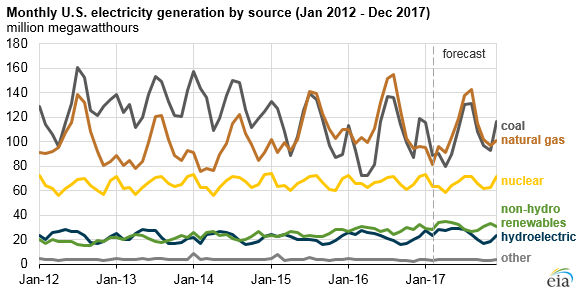US Gas-Firing To Beat Coal This Summer: EIA
US electricity generation fueled by natural gas this summer -- June, July and August 2017 -- will be lower than last summer, but continue to exceed that of any other fuel, including coal-fired generation, for the third summer in a row, forecast the US Energy Information Administration on April 18.
The projected share of total US generation for natural gas is expected to average 34%, which is down from 37% last summer but still exceeds coal’s generation share of 32%, according to the EIA's Short-Term Energy Outlook. It expects shares of both gas and coal are expected to be lower than last summer, as output from hydroelectric and other renewable generators nationally -- and especially in the western US -- is expected to increase.
The Midwest region is the only region of the US in which coal is expected by the EIA this summer to fuel over half of summer power generation (54%). But in all other regions -- Northeast, South and West -- gas will be the largest fuel for power generation, at 44%, 43% and 27% respectively.
In 1Q2017, the Henry Hub natural gas price averaged $3.01/mn Btu, versus $2/mn Btu in 1Q2016, and consequently EIA said that natural gas's share of the nationwide US electricity mix fell from 32% in 1Q2016 to 29% in the first quarter of this year, while coal’s share of generation rose from 29% to 31% over that same period. EIA expects that the Henry Hub price will continue to average slightly more than $3/mn Btu through the summer.

Credit for graphic and underlying data: US Energy Information Administration
More power was generated from natural gas than from coal in the US in 2016 for the first year ever, said the International Energy Agency last month - something that the EIA had forecast would happen. The IEA said the increased US gas-firing was part of a global trend of economic growth delinking from the global growth in energy-related emissions.
Mark Smedley



